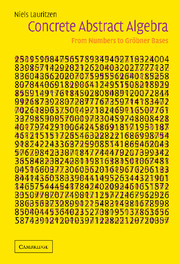2 - Groups
Published online by Cambridge University Press: 05 June 2012
Summary
The concept of a group was first formalized by Cayley (1821–95) around 1854, but many mathematicians computed with group-like structures before that. In fact one of the main results in introductory group theory (see Theorem 2.2.8 below) was already known to Lagrange (1736–1813) in 1771. At this point we need to introduce groups in order to have a language that makes life easier. Dealing with numbers, we have encountered group-like structures several times already. By introducing the basic notions of group theory we get very simple (and nice) proofs of Euler's and Fermat's theorems on congruences (Theorem 1.7.2 and Corollary 1.9.2). By some mystery you are able to do much more powerful mathematics by introducing the three simple axioms defining a group. One point is worth singling out in this chapter: you will increase your level of abstraction from computing with elements in a set to computing with subsets of a set. In fact group theory puts the theory of congruences in a natural context and it will make sense to add and multiply subsets of ℤ consisting of numbers with the same remainder with respect to a positive integer. Groups are also useful outside the world of numbers. Using symmetric and alternating groups we will give a complete treatment of the 15-puzzle invented by Sam Loyd in 1878. Loyd offered a 1000-dollar prize for a correct solution.
Information
- Type
- Chapter
- Information
- Concrete Abstract AlgebraFrom Numbers to Gröbner Bases, pp. 50 - 110Publisher: Cambridge University PressPrint publication year: 2003
